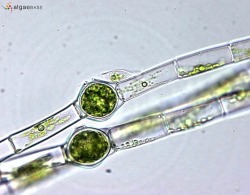
Placing microalgae on the biofuels priority list: a review of the technological challenges
Greenwell HC, Laurens LM, Shields RJ, Lovitt RW, Flynn KJ.
http://rsif.royalsocietypublishing.org/content/7/46/703.long
Microalgae provide various potential advantages for biofuel production when compared with 'traditional' crops. Specifically, large-scale microalgal culture need not compete for arable land, while in theory their productivity is greater. In consequence, there has been resurgence in interest and a proliferation of algae fuel projects. However, while on a theoretical basis, microalgae may produce between 10- and 100-fold more oil per acre, such capacities have not been validated on a commercial scale. We critically review current designs of algal culture facilities, including photobioreactors and open ponds, with regards to photosynthetic productivity and associated biomass and oil production and include an analysis of alternative approaches using models, balancing space needs, productivity and biomass concentrations, together with nutrient requirements. In the light of the current interest in synthetic genomics and genetic modifications, we also evaluate the options for potential metabolic engineering of the lipid biosynthesis pathways of microalgae. We conclude that although significant literature exists on microalgal growth and biochemistry, significantly more work needs to be undertaken to understand and potentially manipulate algal lipid metabolism. Furthermore, with regards to chemical upgrading of algal lipids and biomass, we describe alternative fuel synthesis routes, and discuss and evaluate the application of catalysts traditionally used for plant oils. Simulations that incorporate financial elements, along with fluid dynamics and algae growth models, are likely to be increasingly useful for predicting reactor design efficiency and life cycle analysis to determine the viability of the various options for large-scale culture. The greatest potential for cost reduction and increased yields most probably lies within closed or hybrid closed-open production systems.
PMID: 20031983
After reading the paper, I found some points that I believe are worth mentioning. A lot of good information and perspective were included in this paper in my opinion.
A few challenges that the algae industry currently faces.
Breaking down the composition of algae they look at algae from the following perspective:
Greenwell HC, Laurens LM, Shields RJ, Lovitt RW, Flynn KJ.
http://rsif.royalsocietypublishing.org/content/7/46/703.long
Microalgae provide various potential advantages for biofuel production when compared with 'traditional' crops. Specifically, large-scale microalgal culture need not compete for arable land, while in theory their productivity is greater. In consequence, there has been resurgence in interest and a proliferation of algae fuel projects. However, while on a theoretical basis, microalgae may produce between 10- and 100-fold more oil per acre, such capacities have not been validated on a commercial scale. We critically review current designs of algal culture facilities, including photobioreactors and open ponds, with regards to photosynthetic productivity and associated biomass and oil production and include an analysis of alternative approaches using models, balancing space needs, productivity and biomass concentrations, together with nutrient requirements. In the light of the current interest in synthetic genomics and genetic modifications, we also evaluate the options for potential metabolic engineering of the lipid biosynthesis pathways of microalgae. We conclude that although significant literature exists on microalgal growth and biochemistry, significantly more work needs to be undertaken to understand and potentially manipulate algal lipid metabolism. Furthermore, with regards to chemical upgrading of algal lipids and biomass, we describe alternative fuel synthesis routes, and discuss and evaluate the application of catalysts traditionally used for plant oils. Simulations that incorporate financial elements, along with fluid dynamics and algae growth models, are likely to be increasingly useful for predicting reactor design efficiency and life cycle analysis to determine the viability of the various options for large-scale culture. The greatest potential for cost reduction and increased yields most probably lies within closed or hybrid closed-open production systems.
PMID: 20031983
After reading the paper, I found some points that I believe are worth mentioning. A lot of good information and perspective were included in this paper in my opinion.
A few challenges that the algae industry currently faces.
- Biological hurdles- Identifying a species with optimal characteristics for producing biofuels. Ideally, we would like to have a species that does have a high growth rate, high lipid content, provides easy harvest, and extraction. Obviously, there will have to be a trade off somewhere.
- Standards- A standardized definition of lipids, and what is reported as being lipid in journals. Variation in analytical, chemical, and biochemical variability in final lipid yields results creates difficulty for developing economic models for algae applications.
- Harvesting- The authors identify a major challenge of cell collection. “Harvesting and isolation of products from microalgae cultures is one of the most problematic areas of algal biofuel production technology.”
Breaking down the composition of algae they look at algae from the following perspective:
- 4-8% of dry microalgae is Nitrogen. At the time of publication (Dec 23, 2009) Nitrogen on the world market was $1.4 kg (which is currently worth more than oil $0.40 kg).
- 1 kg of Nitrogen produces 2 kg of carbon dioxide. This is tied to the energy cost of fixing N by using natural gas which is common practice in making fertilizers. This continues to strengthen the argument of the need for low cost nutrient supplies like wastewater.
- Centrifuge- 1 kW h per cubic meter (Source: Molina Grima et al 1996 Productivity analysis of outdoor chemostat culture in tubular air-lift photobioreactors)
- Filtration- 0.3-2 kW h per cubic meter (Source: Molina Grima et al 1996 Productivity analysis of outdoor chemostat culture in tubular air-lift photobioreactors)
- Cell disruption (homogenizer)- 1.5-2 kW h results in 95% protein release for 10 L of processed fluid or about 1 cubic meter of original microalgae culture fluid (assumes a cell concentration factor of 100 by mass)
 RSS Feed
RSS Feed
